Major Achievements

The very first observation of the so-called sigma-hole
Thanks to extensive interdisciplinary cooperation, scientists from CATRIN, the Institute of Physics of CAS, the Institute of Organic Chemistry and Biochemistry of CAS, and the IT4Innovations Ostrava centre have managed to dramatically increase the resolution capabilities of scanning microscopy—from atomic level to subatomic phenomena. They are the first in the world to observe the asymmetric distribution of electron density on single atoms of halogen elements, the so-called sigma-hole. This definitively confirmed its existence, which was theoretically predicted 30 years ago, but direct observation of the phenomenon has long been an unmet challenge. A breakthrough comparable to the first observation of black holes will make it easier to understand chemical reactions and interactions between individual atoms and molecules. It opens the door to the refinement of the material and structural properties of various physical, biological, or chemical systems. The discovery was published by the journal Science.
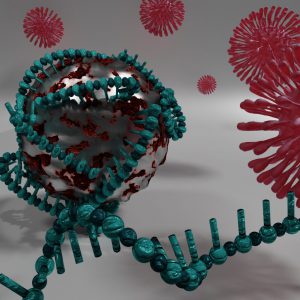
Nanoballs to fight Covid-19
The lack of test kits during the first wave of the covid-19 pandemic prompted scientists in Olomouc to react very quickly. Thanks to years of experience in the research of nanomaterials for biomedical applications, they have developed magnetic nanoballs for testing with the PCR method in a matter of days. Miniature particles with a magnetic core and a thin quartz shell on the surface that can bind viral RNA molecules have become an important part of the new covid-19 testing technology, which was developed in the Institute of Organic Chemistry and Biochemistry of the Czech Academy of Sciences and was particularly helpful in the first phase of the pandemic. Scientists in Olomouc are able to manufacture these nanoballs by inexpensive synthesis and in large quantities. In one cycle, they prepare more than 100 grams of particles, enough for about 100,000 covid-19 tests. These magnetic nanoballs have been used for testing by, for example, the Public Health Institute Ostrava, the University Hospital Královské Vinohrady, Motol University Hospital or Bulovka Hospital, and have also been supplied to a number of commercial entities.
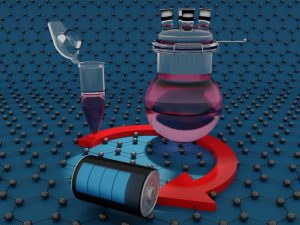
Ultra-thin materials with extraordinary properties
Scientists employed at CATRIN were behind the discovery of fluorographene in 2010 (Small). This thinnest insulator paved the way for developing other graphene-derived ultra-thin materials, the properties of which can be tailored to specific applications in medicine, environmental protection, or high-efficiency catalysts or electronics. Researchers have already confirmed their use for energy storage (AdvFunctMater) as the developed derivatives are light, conductive and allow large amounts of electrical charge to accumulate. They can also serve as single-atom catalysts (AdvMater), assist in the treatment of water contaminated with heavy metals, or, conversely, in the extraction of noble metals such as palladium, gallium or indium from the aqueous environment (ACS Nano).The development of the first graphene-based non-metallic magnet was also one of the crucial results in this area (NatComm).The so-called 2D chemistry aand development of new carbon materials is also the subject of prestigious European Research Council grants in the category of Consolidator and Proof of Concept.
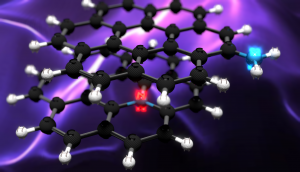
Quantum dots for both medicine and green energy
Unique materials developed by CATRIN scientists include carbon quantum dots. For these small photoluminescent particles of matter with a graphite structure no larger than ten nanometres in size, the researchers found very promising applications. In the past, scientists in Olomouc have demonstrated the use of different types of quantum dots as miniature ‘thermometers’ for in vivo temperature measurements in living cells (ACS Nano), bioimaging (AdvMater) in medical diagnostics, photothermal cancer therapy (LightSciAppl), development of LEDs (AdvOptMater) or as efficient photocatalysts (ChemRev). They also designed interesting applications in the optoelectronics. Among other things, they used carbon dots to construct photoluminescent solar concentrators enabling to concentrate and ‘collect’ solar radiation, which is converted to electrical energy by a solar cell (Nanoscale).
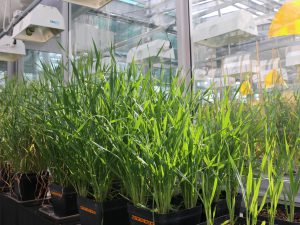
Transgenic barley for the production of cathelicidin
Modification of the barley genome so that the plant can produce cathelicidin, one of the most well-known antimicrobial peptides in human skin – that is the achievement of molecular farming by local experts. The technology they have developed may be the basis for large-scale production of a peptide that is part of the human immune system and acts as a natural antibiotic (https://patentscope.wipo.int/search/en/detail.jsf?docId=WO2019052588). Its commercial application is still complicated due to its high production cost, but the use of genetically modified barley could significantly reduce it, according to scientists.
Because peptides have limited stability and, in addition, can be toxic to the host plant, the researchers had to optimize a number of parameters. After selecting the most efficient production strategy, the selected genes were introduced into barley. Cultivated transgenic plants produced cathelicidin only in the caryopsis. The researchers tested its antimicrobial activity and confirmed that the peptide or its variants thus obtained do not have a negative effect on the plant itself (BiotechnolJ).
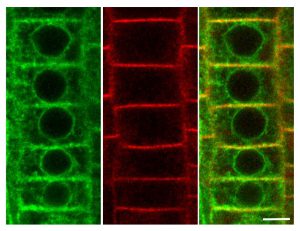
A dogma associated with plant hormones rebutted
Knowledge about the mechanism of action of plant hormones has been significantly changed by research, in which scientists working at CATRIN participated together with colleagues from Palacký University and other research institutions from Czech Republic as well as from abroad. Using fluorescently labeled cytokinin, they have shown that the receptors for these plant hormones, which are essential for triggering molecular-biological processes in the plant, are also found on the cell surface. They also learned under what circumstances this happens and in what pathways the receptors move from the inside of the cell to its surface and vice versa. The age-old dogma that these receptors need to be sought only inside cells has thus been rebut)ted. Cytokinins are among the key hormones that are absolutely necessary for the growth and development of plants and their adaptation to adverse environmental conditions. A closer understanding of their regulatory role can help, among other things, in the development of growth regulators derived from these hormones and technologies useful in sustainable agriculture (NatComm).

